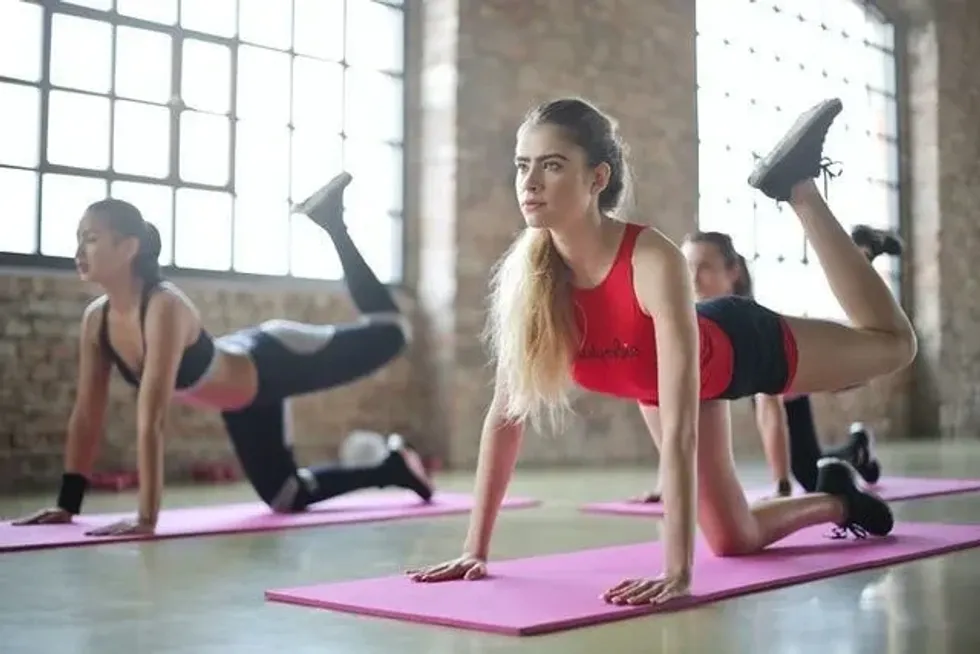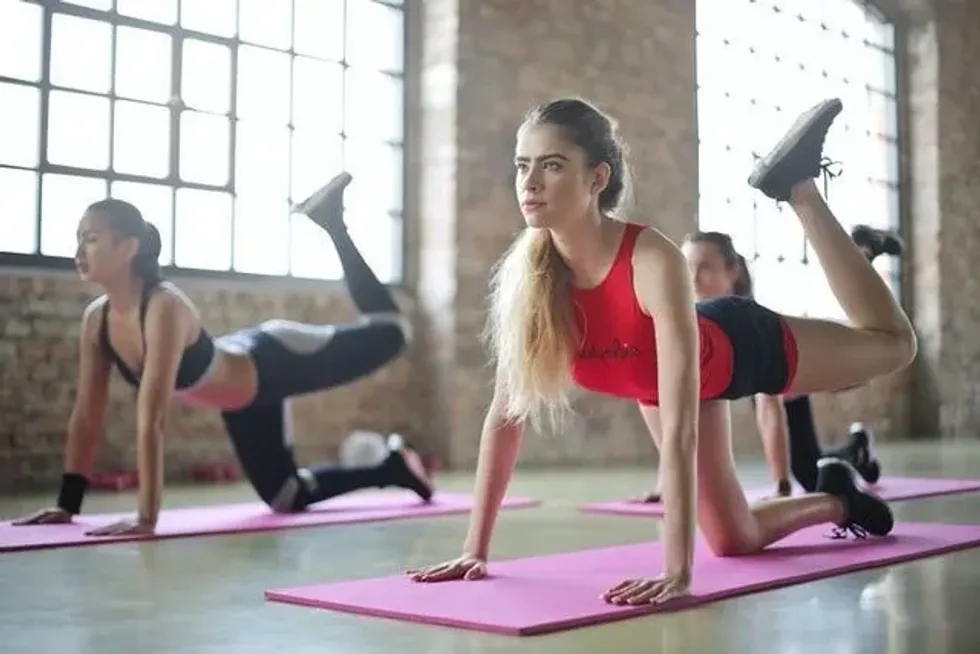Aerobics is all about moving your body, breaking a sweat, and feeling great. It's more than a popular workout; it's a way to boost your overall health and energy. Aerobics involves using big muscle groups and can be adapted for anyone, whether you're just starting or you're already active. It's great for losing weight and getting fitter.
It's important to know a few things about aerobics when you start your fitness journey. Activities like brisk walking or dance-based workouts use oxygen to power your body for a longer time. This helps pump more oxygen-rich blood to your muscles and keeps your heart and lungs healthy.
As you prepare for your next aerobic session, think of it as a chance to lift your spirits, manage your blood sugar, and sharpen your mind. It's not just about getting through the workout, it's about celebrating what your body can do. Let's explore how aerobics can change your body, boost your mental health, and improve your life overall.
The Abundant Benefits Of Aerobic Exercise

Are you curious about the specific benefits that regular aerobic exercise can unleash? It's not just about shedding pounds; it's a holistic approach to a healthier you.
- Moderate aerobic exercises are like a playful break; they feel good and keep you active without tiring you out too much. You can chat with a friend, enjoy your surroundings, and feel more energized and happy.
- Aerobic exercise significantly boosts your cardiovascular health by strengthening the heart and blood vessels, ensuring you maintain a healthy heart rate and blood flow.
- Regular aerobic activity can decrease your chances of developing conditions like heart disease, diabetes, and stroke.
- Explore high-intensity aerobic exercise if you're aiming for a more challenging session that effectively burns fat and builds endurance.
- Moderate-intensity aerobic exercises are perfect for maintaining a healthy weight and enhancing body weight control with less strain on the joints.
- Controlled blood sugar levels are a fantastic byproduct of aerobic activities, as the exercises improve insulin sensitivity and help manage diabetes.
- Mental health gets a boost from aerobic exercises, which help improve cognitive performance, making you feel sharper and more focused.
- Aerobic exercise releases endorphins, those natural feel-good hormones that can improve your mood and lower stress levels.
- Over time, regular aerobic workouts can increase your stamina and reduce fatigue during physical activity.
- If high blood pressure is a concern, engaging in consistent aerobic workouts can lower blood pressure naturally, without solely relying on medication.
- Staying active through aerobic exercise can bolster your immune system, helping you fight off illnesses more effectively.
- Aerobic training improves lung function by increasing demand on the respiratory system during exercises such as jogging or stair climbing.
- By providing so many health benefits, aerobic exercises could contribute to longevity, giving you more years to enjoy life.
- Maintaining aerobic fitness can keep you mobile and independent as you age, allowing you to continue doing the things you love.
- Many aerobic activities, like group fitness classes or team sports, can connect you with others and add a social element to your routine.
Choosing The Right Aerobic Exercise For You

How much aerobic exercise you need can vary, but finding the right balance and activity that suits your lifestyle can elevate the experience and the results.
- Experiment with aerobic activities such as cycling, swimming, or aerobic dancing to find what you enjoy and can commit to long-term.
- Sports medicine experts recommend at least 150 minutes per week of moderate aerobic exercise or 75 minutes per week of vigorous exercise for adults.
- For beginners, an exercise program that includes moderate-intensity exercise such as walking or light jogging is a sustainable way to start.
- Aerobic workouts using exercise equipment at your local gym can provide structure and a variety of options to keep your training versatile.
- Weaving aerobic activities into your routine, like jogging, cycling, or even brisk walking to work, can create seamless integration with your daily life.
Elevating Your Aerobic Fitness Level
Improving your aerobic fitness doesn't happen overnight, but with dedicated aerobic training, you can witness impressive progress over time.
- Regular aerobic exercise is the backbone of improving your cardiorespiratory fitness, which isessentially how well your heart, lungs, and muscles work together.
- Aerobic exercise benefits are maximized when incorporated alongside a healthy diet, creating a lifestyle conducive to holistic health.
- Start with aerobic exercises that involve the entire body, and gradually increase the intensity to challenge your cardiovascular system and build endurance.
- Monitor your breathing and heart rate to assess your workout intensity and employ the 'talk test' to check if you're in the moderate or vigorous intensity zone.
- To improve aerobic fitness, consistency is key; even 20-30 minutes a day can make a substantial difference in your health and vitality.
Blending Aerobic And Anaerobic For Maximum Gain

Aerobic activity isn't the sole contender; mixing in anaerobic exercise can offer a comprehensive fitness strategy.
- Understanding the difference between aerobic and anaerobic exercise is vital; while aerobics relies on oxygen for energy, anaerobic exercises, such as weightlifting, do not.
- Incorporating both aerobic and anaerobic exercises into your exercise physiology can create a balanced workout that targets both endurance and strength.
- Exercises such as sprinting or high-intensity interval training (HIIT) combine the benefits of both aerobic and anaerobic activity, boosting overall fitness.
- Personalized workout programs that include aerobic workouts for endurance and anaerobic exercises for muscle building can cater to individual fitness goals.
Maintaining A Complete, Balanced Approach
The pursuit of a fit and healthy body goes beyond just physical activity. A comprehensive strategy includes aerobic training, a sensible diet, and attention to wellness.
- Aerobic exercises are the cornerstone of fitness, but they should be part of an overall wellness strategy that includes a healthy weight maintenance plan.
- Aim for balance by pairing your aerobic workout with a nutritious diet rich in whole foods to support the energy demands of your exercise routine.
- Regular check-ups with healthcare professionals can guide your fitness journey, ensuring that your aerobic exercise program aligns with your health needs.
FAQs
Can aerobic exercise help with weight loss?
Yes, aerobic exercises like jogging, cycling, and swimming can help you lose weight by burning fat and calories. Coupled with a healthy diet, regular aerobic activity can create the calorie deficit necessary for weight loss.
How does aerobic exercise reduce high blood pressure?
Aerobic exercise helps lower blood pressure by strengthening the heart, which pumps blood more efficiently, reducing the pressure on your blood vessels, and promoting better circulation.
What makes aerobic exercise different from other types of workouts?
Aerobic exercise involves continuous, rhythmic physical activity that increases your heart rate and breathing. It's different from resistance or strength training, which focuses on building muscle through repetitive motions like lifting weights.
Can aerobic exercise improve my joint health?
Yes, low-impact aerobic activities like swimming and cycling can improve joint flexibility and strength without putting too much strain on them, which can be beneficial for individuals with joint pain or arthritis.
Will aerobic exercise help me if I'm trying to build muscle?
While aerobic exercise is primarily for improving cardiovascular fitness and burning fat, it can also complement muscle-building goals by increasing endurance and facilitating fat loss.
Do I need special equipment to start with aerobic exercise?
Not necessarily. Many aerobic exercises, like running and walking, require no equipment at all. For some activities like cycling or rowing, you will need a bicycle or a rowing machine, respectively.
Can older adults safely participate in aerobic exercise?
Definitely! Older adults can greatly benefit from aerobic exercise with activities adjusted to their fitness levels, such as chair aerobics, walking, or water aerobics, to help maintain mobility and heart health.
Is it okay to do aerobic exercise every day?
While it's generally safe to do some form of aerobic exercise every day, it's essential to listen to your body and allow for rest days, especially after intense sessions, to prevent overtraining and injury.
How quickly can I see results from regular aerobic exercise?
Results can vary, but many people notice improvements in energy levels and mood after just a few sessions. More significant changes, like weight loss and increased fitness, can take a few weeks to become noticeable.
How can I make sure I'm doing aerobic exercise correctly?
To ensure proper form and technique, consider working with a fitness trainer or attending group classes. It's also important to start slowly and gradually increase intensity to avoid injury.
Can aerobic exercise aid in recovery from an illness?
Yes, with a doctor's approval, aerobic exercise can often help in the recovery process by building strength and stamina. Always consult with your healthcare provider before starting any new exercise after an illness.
Do I need to warm up before aerobic exercise?
Yes, warming up is essential to prepare your muscles and cardiovascular system for the upcoming activity. It can help reduce the risk of injury and improve your performance.
What should I do if I miss an aerobic workout?
Don't worry; missing one workout isn't a big deal. Just pick up where you left off with your next scheduled session, and try to stay consistent in the future.
How can I stay motivated to continue with aerobic exercise?
Setting clear goals, keeping your routine varied and fun, tracking your progress, and working out with friends or in a group can all help keep motivation high.
Aerobic exercise combines movement, dedication, and well-being in a way that benefits you in many areas. It's great for your heart, helps with weight management, and clears your mind, among other things.
You can start with moderate-intensity workouts that are gentle and steady, or go for more excitement with high-intensity training. Remember, every step, pedal, or beat you follow takes you closer to a healthier and happier life. Let your understanding of aerobics guide you on this fulfilling fitness journey.
Related Articles Around the Web












